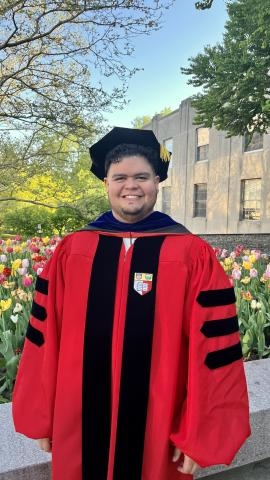Evolution of Feline and Canine Parvoviruses: Understanding the Capsid Structure, the Natural Variation, and the Antibody Selection
Student Name:
Robert Lopez-Astacio
Student Concentration:
Immunology and Infectious Disease
Principal Investigator:
Colin Parrish
Degree Conferral Date:
May 2023
Committee Member 1:
Hector Aguilar-Carreno
Committee Member 2:
John Parker
Committee Member 3:
Gary Whittaker
Abstract:
Parvoviruses, including feline (FPV) and canine parvovirus (CPV), are among the smallest and structurally simplest viruses described, both in their genome composition as well as their overall icosahedral capsid structure. Their capsids are composed of variants of a single structural protein that controls many of the required steps involved in replication, and for the interaction with many host-derived ligands and molecules, including cellular receptors and antibodies. Despite their apparent simplicity, FPV and CPV replication and spread involve complex and dynamic interactions that lead to broad and variable host ranges, rapid adaptation, successful sustained transmission, host immunity evasion, and a long evolutionary trajectory. In this dissertation I have used FPV and CPV as models to better understand capsid structures and functions, to describe the genetic variation in virus populations as a result of their many and intricate interactions with host-derived molecules such as receptors and antibodies, and to describe and characterize their overall evolutionary history.
I found that CPV capsids acquire mutations during their replication, and functional mutations are selected in the face of neutralizing antibodies. Those selected residues fell within or were close to antibody footprints, and they generally avoided receptor binding sites despite the overlapping of those two. Antibody-selected mutations in capsids result in decreased binding to the antibodies, showing that those are escape mutations. Additionally, I found that those antibody escape mutations were still mostly restricted to the same general residues in the viral capsid when using mutated versions of the antibodies. Many of these in vitro-selected mutations are also found in natural isolates, suggesting they are linked to the natural variants that evade the host-immune system.
Despite the long evolutionary trajectory of FPV, I found that all FPV strains are ~99% identical in nucleotide sequence. I was also able to reveal the landscape of mutations that have become widespread in the FPV genomes during 57 years of its evolutionary history in cats and other susceptible hosts, and I compared the results from FPV to what has been seen for CPV. I also found that ~66% of the substitutions that became widespread in CPV genomes are present at low frequencies among the FPV natural variants, and also showed that most of the FPV vaccines currently in use are derived from one virus first isolated in the 1960s. The FPV-like viruses evolved at similar rates to CPV-derived viruses in their different hosts, but most substitutions in FPV within the capsid protein gene were silent changes. The small number of coding changes in the FPV lineage do not appear to alter the known antigenic epitopes of parvoviruses, suggesting the continued efficaciousness of the 60-year-old vaccines in cats.
The results of this dissertation provide new information that is immediately relevant to the emergence of new viruses, and they also provide new insights into how viruses evolve, adapt, overcome species barriers, and persist in natural reservoirs, as well as revealing the complicated and sophisticated roles of parvovirus capsids despite their seeming simplicity.
Publications:
López-Astacio, Robert & Adu, Oluwafemi & Goetschius, Daniel & Lee, Hyunwook & Weichert, Wendy & Wasik, Brian & Frueh, Simon & Alford, Brynn & Voorhees, Ian & Flint, Joseph & Saddoris, Sarah & Goodman, Laura & Holmes, Edward & Hafenstein, Susan & Parrish, Colin. (2023). Viral capsid, antibody, and receptor interactions: experimental analysis of the antibody escape evolution of canine parvovirus. bioRxiv : the preprint server for biology. 10.1101/2023.01.18.524668.
Jager, Mason & Tomlinson, Joy & Lopez-Astacio, Robert & Parrish, Colin & Van de walle, Gerlinde. (2021). Small but mighty: old and new parvoviruses of veterinary significance. Virology Journal. 18. 10.1186/s12985-021-01677-y.
Wünschmann, Arno & Lopez-Astacio, Robert & Armién, Aníbal & Reed, Leslie & Parrish, Colin. (2020). Parvovirus-induced encephalitis in a juvenile raccoon. Journal of Veterinary Diagnostic Investigation. 33. 104063872096738. 10.1177/1040638720967381.
Almodovar, Sharilyn & Wade, Brandy & Porter, Kristi & Smith, Justin & Lopez-Astacio, Robert & Bijli, Kaiser & Kang, Bum-Yong & Cribbs, Sushma & Guidot, David & Molehin, Deborah & Mcnair, Bryan & Pumarejo-Gomez, Laura & Hernandez, Jaritza & Salazar, Ethan & Martinez, Edgar & Huang, Laurence & Kessing, Cari & Suarez, Edu & Pruitt, Kevin & Sutliff, Roy. (2020). HIV X4 Variants Increase Arachidonate 5-Lipoxygenase in the Pulmonary Microenvironment and are associated with Pulmonary Arterial Hypertension. Scientific Reports. 10. 10.1038/s41598-020-68060-9.
Wünschmann, Arno & Lopez-Astacio, Robert & Armien, Anibal & Parrish, Colin. (2020). Cerebellar hypoplasia and dysplasia in a juvenile raccoon with parvoviral infection. Journal of Veterinary Diagnostic Investigation. 32. 463-466. 10.1177/1040638720912229.
Voorhees, Ian & Lee, Hyunwook & Allison, Andrew & Lopez-Astacio, Robert & Goodman, Laura & Oyesola, Oyebola & Omobowale, Temidayo & Fagbohun, Olusegun & Dubovi, Edward & Hafenstein, Susan & Holmes, Edward & Parrish, Colin. (2019). Limited Intrahost Diversity and Background Evolution Accompany 40 Years of Canine Parvovirus Host Adaptation and Spread. Journal of Virology. 94. 10.1128/JVI.01162-19.



